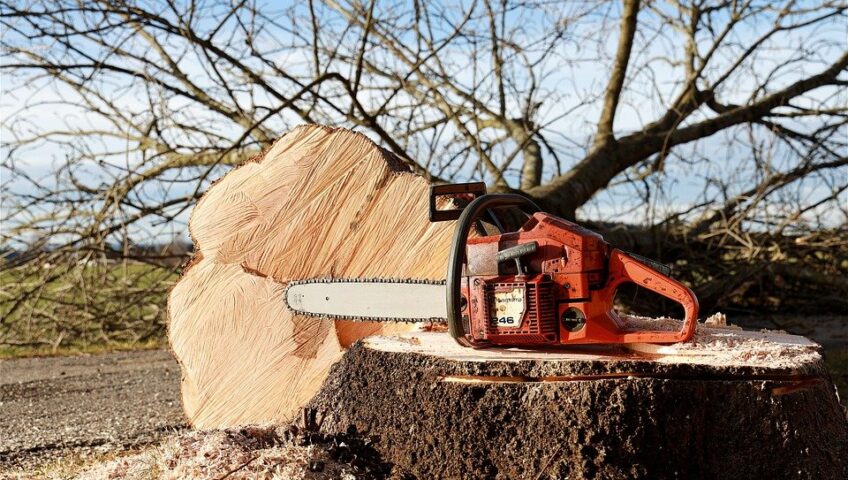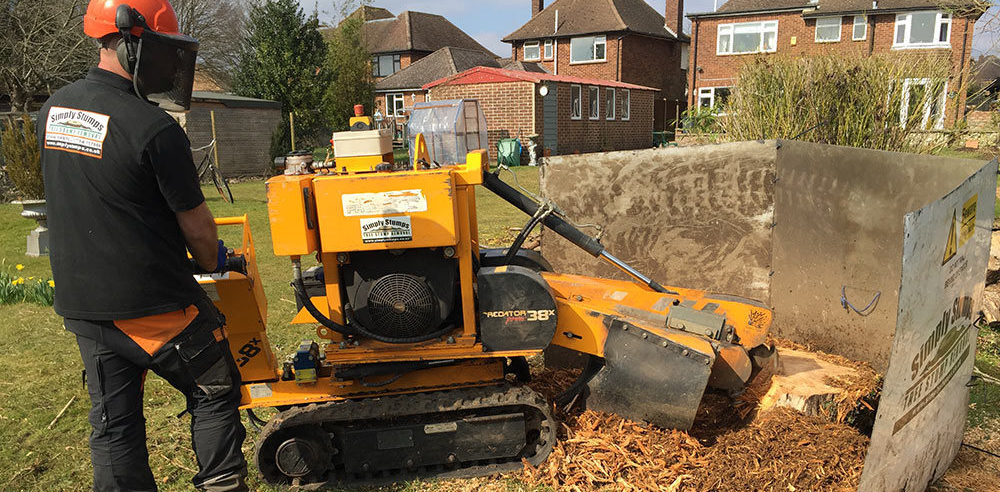Are you grappling with the decision of whether to opt for stump grinding or removal in your landscape? Determining the best approach to address this issue can be challenging. Both methods have their own set of advantages and disadvantages depending on various factors, such as cost, time efficiency, environmental impact, safety concerns, and the long-term effects on your landscape. This article will delve into the intricacies of stump grinding and removal, highlighting key points to help you make an informed decision.
Understanding the Basics of Stump Grinding
If you have ever wondered backyard stump grinding, stump grinding is a popular and effective solution. The process involves using a specialized machine equipped with sharp cutting teeth to chip away at the stump until it is reduced to wood chips and debris.
The Process of Stump Grinding
The stump grinding process typically begins with the removal of any rocks, vegetation, or debris surrounding the stump. This ensures a clear area for the machine to operate smoothly. The grinder is then positioned over the stump, and the operator systematically grinds the stump from side to side. As the grinding progresses, the stump is gradually reduced to a mound of wood chips.
It is important to note that stump grinding is not a one-size-fits-all solution. The size and age of the stump, as well as the type of tree it belonged to, can impact the duration and complexity of the grinding process. Larger stumps or those with extensive root systems may require more time and effort to grind down completely.
Pros and Cons of Stump Grinding
One of the significant advantages of stump grinding is its cost-effectiveness. In most cases, grinding stumps proves to be a more affordable option compared to complete removal. Additionally, stump grinding prevents the need for extensive excavation, thereby minimizing disruption to the surrounding landscape.
However, it’s crucial to consider the potential drawbacks as well. Stump grinding does not completely eliminate the stump’s root system, which means that new sprouts may continue to grow. Although these sprouts are generally easier to manage and remove compared to a full-sized stump, they still require regular maintenance.
Another advantage of stump grinding is the speed at which it can be completed. Unlike traditional stump removal methods that may take days or even weeks, stump grinding can often be finished in a matter of hours, depending on the size and complexity of the stump. This quick turnaround time allows property owners to reclaim their land and use it for other purposes sooner rather than later.
Delving into Stump Removal
If you prefer a more comprehensive approach to eliminate tree stumps, stump removal might be the right choice for you. Unlike grinding, which shreds the stump, removal involves extracting the entire stump, including the root system, from the ground.
The Procedure of Stump Removal
Stump removal typically involves digging and excavating the stump and its root system using heavy machinery. This method targets complete eradication, leaving no remnants of the stump behind. Once the stump is dug out, it can either be used as mulch or entirely disposed of depending on your preference.
When the stump removal process begins, professionals assess the size and condition of the stump to determine the best approach. Heavy-duty equipment such as stump grinders, chainsaws, and excavators are commonly used to uproot the stump effectively. The excavation process can be intricate, especially for older and larger trees with extensive root systems that have spread deep into the soil.
Advantages and Disadvantages of Stump Removal
By completely removing the stump, this method eradicates any potential for regrowth. It also creates a cleaner and more aesthetically pleasing landscape. Additionally, stump removal eliminates any tripping hazards and makes it easier to repurpose the area for other landscaping projects.
However, stump removal can be a labor-intensive process and requires significant excavation, which may result in disruption to the surrounding terrain. It also tends to be more expensive than stump grinding, mainly due to the additional labor and equipment involved.
Factors to Consider When Choosing Between Stump Grinding and Removal
When faced with the decision of whether to opt for stump grinding or removal, it’s important to delve deeper into the intricacies of each method. By exploring various factors, you can make a well-informed choice that aligns with your specific needs and preferences.
One crucial aspect to consider is the size and location of the stump. Larger stumps or those situated in challenging areas may be better suited for removal, as grinding might not fully eradicate them. On the other hand, smaller stumps that are easily accessible could be efficiently dealt with through grinding, saving you time and effort.

Cost Comparison: Stump Grinding vs Removal
Delving into the realm of costs, it’s evident that stump grinding often emerges as the more cost-effective option. The intricate process of removal, involving heavy machinery and labor-intensive techniques, can lead to a higher price tag. Nevertheless, it’s essential to consider the long-term implications and benefits of each method in relation to your budget constraints.
Time Efficiency: Grinding or Removal?
When time is a critical factor in your decision-making process, the efficiency of stump grinding shines through. Equipped with powerful grinding machines, professionals can swiftly reduce a stump to wood chips, completing the task in a fraction of the time required for removal. Conversely, the extensive nature of removal procedures may extend the project timeline significantly.
Environmental Impact of Both Methods
Environmental consciousness plays a pivotal role in the choice between stump grinding and removal. Opting for stump grinding not only eliminates the eyesore of a stump but also produces wood chips that can be repurposed as organic mulch, promoting sustainability. Conversely, stump removal eradicates the entire stump, potentially preventing any future regrowth and creating a clean slate for new tree planting endeavors.
Safety Concerns Associated with Stump Grinding and Removal
While stump grinding and removal are generally safe procedures when performed by professionals, it’s important to be aware of potential risks and hazards associated with each method.
Stump grinding is a common method used to remove tree stumps by grinding them into small wood chips. While this process is efficient, it involves the use of heavy machinery such as stump grinders. These machines can be dangerous if not handled properly, as they have sharp rotating blades that can cause serious injuries if proper safety precautions are not taken. Operators must wear appropriate personal protective equipment, such as goggles, gloves, and ear protection, to prevent injuries from flying wood chips and debris.
Risks Involved in Stump Grinding
Stump grinding involves the use of heavy machinery, which can pose safety risks if not operated correctly. Flying wood chips, fragments, or debris can also be hazardous, necessitating the use of appropriate protective equipment.
Additionally, stump grinding can unearth hidden obstacles such as rocks, metal objects, or roots, which can damage the equipment or cause injury if not detected and removed beforehand. It is crucial for operators to conduct a thorough inspection of the work area before starting the grinding process to ensure a safe working environment.
Potential Hazards of Stump Removal
In the case of stump removal, the extensive excavation process can create unstable ground conditions. This can pose risks to both the operator and nearby structures. It’s essential to enlist the services of experienced professionals to minimize potential hazards.
Furthermore, stump removal often involves digging deep into the ground to extract the entire root system. This excavation process can weaken the soil structure and destabilize the surrounding area, increasing the risk of sinkholes or ground collapses. Proper safety measures, such as shoring up the excavation site and using appropriate machinery, are essential to prevent accidents and ensure the safety of both workers and property.
Long-Term Effects of Stump Grinding and Removal
Considering the long-term effects on your landscape is crucial when making a decision between stump grinding and removal.
Impact on Landscape After Stump Grinding
After the completion of stump grinding, wood chips and debris remain in the area. These can be repurposed as mulch or left to naturally decompose, enriching the soil. However, it’s important to recognize that new sprouts may still emerge from the remaining root system.
Additionally, the process of stump grinding can have a positive impact on the aesthetics of your landscape. By removing the visible portion of the stump, you can create a more visually appealing outdoor space. The mulch left behind can also act as a natural weed barrier, reducing the need for chemical weed control methods.

Consequences on Landscape Following Stump Removal
With stump removal, the area is left free of any remnants or potential regrowth. This allows for easier landscaping and repurposing of the area. However, it’s crucial to consider the impact of excavation on the surrounding terrain and plan accordingly for any required restoration.
Furthermore, stump removal can promote better soil health in the long run. By completely eliminating the stump and its root system, you prevent any potential competition for nutrients with other plants in the area. This can lead to healthier vegetation and improved overall growth in your landscape.
Ultimately, the choice between stump grinding and removal depends on various factors, including your budget, time constraints, environmental concerns, safety considerations, and the desired long-term outcome for your landscape. Assessing these aspects and consulting with professionals will enable you to make an informed decision that aligns with your preferences and requirements. Whether you opt for stump grinding or removal, rest assured that both methods offer effective solutions to eliminate unsightly tree stumps and create a more visually appealing outdoor space.
More to Read: Emergency Stump Removal Services: Quick Solutions for Your Needs

